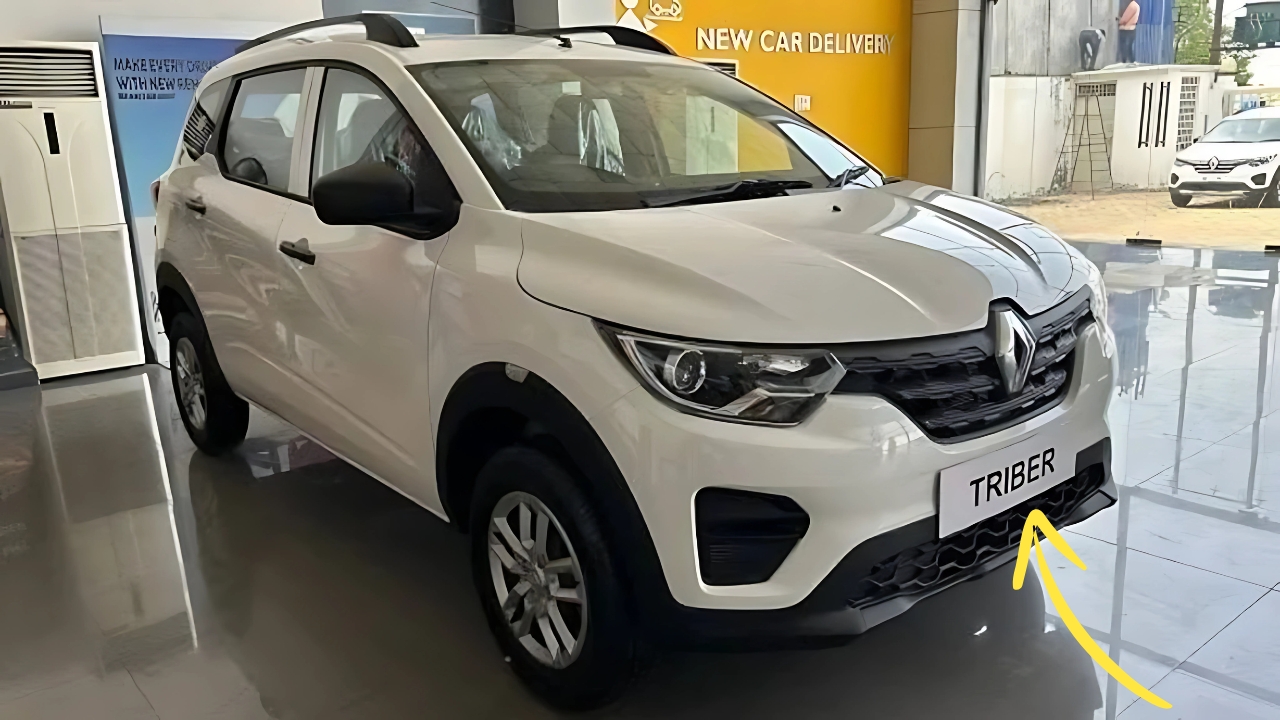New Renault Triber: In the increasingly crowded segment of compact multi-purpose vehicles, manufacturers face the challenging task of balancing affordability with genuine utility.
The refreshed Renault Triber represents a particularly interesting approach to this equation, offering seven-seat flexibility within a sub-four-meter footprint at a price point typically associated with basic hatchbacks.
Having spent two weeks with the latest iteration across varied Indian driving conditions, I’ve developed a nuanced understanding of how this French-designed, Indian-built vehicle addresses the unique needs of emerging market families.
New Renault Triber: Market Context: Understanding the Triber’s Mission
To properly evaluate the Triber, one must first understand its distinct positioning within both Renault’s lineup and the broader automotive landscape.
Launched initially in 2019 and now refreshed for 2025, the Triber occupies a carefully defined niche between basic hatchbacks and more expensive compact MPVs.
This positions it as an entry-level family vehicle for first-time buyers upgrading from two-wheelers, as well as a practical second car for more affluent households.
This strategic positioning reflects Renault’s recognition of a specific gap in the market – affordable vehicles capable of accommodating extended families without the compromises of cramped hatchbacks or the expense of larger MPVs.
The sub-four-meter length (3990mm) brings significant tax advantages in the Indian market, making the seven-seat configuration even more remarkable as an engineering achievement.
Design Execution: Maximizing Potential
The Triber’s exterior design successfully balances practical requirements with visual appeal. While clearly emphasizing function over form, the refreshed model introduces subtle enhancements that elevate its appearance beyond purely utilitarian.
The revised front fascia features a more prominent grille with chrome embellishments that create visual width, while redesigned headlamps incorporate LED daytime running lights in a distinctive C-shaped pattern – a family design element shared with other Renault models.
In profile, the vehicle’s proportions reveal thoughtful engineering. The relatively high roofline enables proper headroom for all three rows without creating an excessively van-like silhouette, while the short hood maximizes interior space within the limited overall length.
The 182mm ground clearance – substantial for this segment – provides meaningful capability on rough roads without requiring an awkward step-up for entry and exit.
The rear design emphasizes width and stability through horizontal elements, with three-dimensional taillamps and a chrome garnish that visually connects them.
New alloy wheel designs on higher trims (my test vehicle featured the 15-inch diamond-cut options) add a touch of sophistication without appearing pretentious.
The roof rails serve both aesthetic and functional purposes, supporting up to 50kg of additional cargo when needed.
What impresses most about the design is its honesty – there’s no attempt to disguise the vehicle’s practical nature through overwrought styling or SUV-like pretensions. Instead, the design embraces its purpose with a confidence that feels refreshingly straightforward.
Interior Innovation: Space Multiplication
Step inside the Triber, and the focused interior innovation becomes immediately apparent. The dashboard layout prioritizes horizontal elements that enhance the perception of width, while the dual-tone treatment (ivory and black in my test vehicle) creates visual separation that reduces apparent mass.
Material quality exceeds expectations at this price point, with thoughtfully textured hard plastics and fabric inserts that add visual and tactile interest.
The driving position offers good visibility through the expansive windshield, with adequate adjustment range to accommodate varied physiques.
The instrument panel combines analog gauges with a 3.5-inch digital display that provides essential information without overwhelming complexity.
The 8-inch touchscreen infotainment system offers wireless Apple CarPlay and Android Auto connectivity – a meaningful upgrade from the previous generation that enhances everyday usability.
Where the Triber truly distinguishes itself is in seating configuration flexibility. The EasyFix second row splits 60:40 and slides to balance legroom between middle and rear passengers, while the third row features Renault’s innovative EasyFold system that allows complete removal when maximum cargo capacity is needed.
This modular approach creates eight distinct configurations ranging from seven-seat people carrier to two-seat cargo hauler with 625 liters of storage.
During my testing period, this flexibility proved invaluable across varied scenarios – from accommodating three adults and four children during a family outing to transporting an unexpectedly large furniture purchase with the third row removed and second row folded.
The third row, while understandably tight for full-sized adults on longer journeys, proved entirely adequate for children and shorter adults on trips under an hour – a realistic use case for most owners.
Storage solutions demonstrate similar thoughtfulness, with 31 liters of compartments distributed throughout the cabin.
The cooled center storage box preserves beverages and snacks even in scorching conditions, while dedicated smartphone shelves for second-row passengers reflect contemporary family needs.
The dual glove boxes provide separate storage for documents and personal items, enhancing everyday organization.
Performance Characteristics: Pragmatic Propulsion
The Triber’s powertrain represents perhaps its most pragmatic aspect. The 1.0-liter three-cylinder naturally aspirated engine produces 72 horsepower and 96 Nm of torque – modest figures that prioritize efficiency over outright performance.
In the updated model, this engine receives refinement enhancements that noticeably reduce vibration at idle and under acceleration compared to earlier iterations.
The five-speed manual transmission in my test vehicle offered precise shift action with well-defined gates, though the clutch engagement point required some familiarization.
The optional AMT automated manual provides convenience in urban environments at some cost to responsiveness and smoothness – a reasonable compromise given the price positioning.
Performance must be evaluated within context rather than absolute terms. With one or two occupants, the Triber accelerates adequately for urban environments, merging confidently with traffic and maintaining highway speeds without strain.
Fully loaded with seven passengers and cargo, however, progress becomes more measured, requiring thoughtful gear selection and momentum management, particularly on inclines.
More impressive is the suspension tuning, which demonstrates sophisticated damping characteristics despite the simple torsion beam rear setup.
Speed bumps and potholes are absorbed with composure that belies the affordable positioning, while body roll remains controlled during moderate cornering.
The 185/65 R15 tires provide adequate grip without excessive road noise, contributing to the surprisingly refined overall experience.
Efficiency Economics: The Ownership Equation
The Triber’s economy extends beyond purchase price to encompass running costs – a critical consideration for its target demographic.
During my testing period, which included a mix of congested urban driving and open highway stretches, the vehicle consistently delivered 16-18 km/l (approximately 38-42 mpg) – figures that translate to meaningful financial impact for budget-conscious owners.
Maintenance economics prove equally compelling. Service intervals of 10,000 kilometers strike a reasonable balance between maintenance needs and owner convenience, while the straightforward mechanical package reduces potential complication.
Renault’s expanded service network addresses previous concerns about support in smaller towns and cities, though parts availability can still lag behind more established competitors in some regions.
Insurance costs benefit from the vehicle’s modest engine displacement and straightforward repairability, while the light weight (approximately 965 kg) contributes to reduced tire wear compared to heavier alternatives.
These seemingly minor considerations compound into significant total cost of ownership advantages over a typical ownership cycle.
Safety Considerations: Progressive Improvement
Safety features represent an area of progressive improvement for the Triber. The refreshed model now offers four airbags as standard across the range, with six airbags available on higher trims – a meaningful enhancement over the previous generation.
ABS with electronic brakeforce distribution and brake assist come standard, as do rear parking sensors and a seatbelt reminder system for the driver and front passenger.
The underlying structure incorporates energy-absorbing crumple zones and impact beams for side protection, addressing fundamental safety considerations despite the cost constraints.
While active safety systems like electronic stability control remain limited to higher trims, their inclusion at all represents progress in a segment where such features were previously unavailable.
New Renault Triber:
The refreshed Renault Triber ultimately succeeds through clear understanding of its target audience and judicious feature prioritization.
Rather than attempting to be all things to all people, it delivers genuine seven-seat capability and flexible interior configurations at a price point accessible to families making their first four-wheeler purchase.
This focused approach creates a compelling value proposition for buyers who prioritize practical flexibility over perceived status or unnecessary features.
In achieving genuine innovation within strict cost constraints, Renault has demonstrated that thoughtful engineering can democratize features previously available only at much higher price points.
For families navigating the complex compromise between budget limitations and space requirements, the Triber offers a refreshingly honest solution that enhances mobility without imposing financial strain.
In this essential purpose – expanding the possibilities of affordable family transportation – it achieves a significance that transcends its modest specification sheet and deserves recognition as a meaningful contribution to personal mobility in emerging markets.
Also read this –

